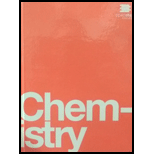
What is a spontaneous reaction?
Interpretation: The meaning of spontaneous reaction should be determined.
Concept Introduction: The symbolic representation of a chemical reaction in the form of formulae and symbols in which reactants are written on left hand side and the products are written on right hand side is known as chemical equation.
The chemical reaction can be classified as spontaneous and non-spontaneous.
Answer to Problem 1E
Spontaneous reaction is defined as the reaction which occurs without any external source.
Explanation of Solution
The reactions that occurs without any intervention in the given set of conditions is said to be a spontaneous reaction.
When the reactions result in increase in entropy and decrease in enthalpy of the system, thereactions are said to be favorable.
For example, a roaring of bonfire, an exothermic reaction that is energy is released in this reaction and the entropy of the system increases.
The reaction which occurs on its own under the given set of conditions without any external source is known as spontaneous reaction.
Want to see more full solutions like this?
Chapter 16 Solutions
Chemistry by OpenStax (2015-05-04)
Additional Science Textbook Solutions
College Physics
General, Organic, and Biological Chemistry (3rd Edition)
Chemistry: The Central Science (13th Edition)
Chemistry: Structure and Properties
Introductory Chemistry (6th Edition)
- Is the following reaction spontaneous as written? Explain. Do whatever calculation is needed to answer the question. SO2(g)+H2(g)H2S(g)+O2(g)arrow_forwardConsider the decomposition of red mercury(II) oxide under standard state conditions.. 2HgO(s,red)2Hg(l)+O2(g) (a) Is the decomposition spontaneous under standard state conditions? (b) Above what temperature does the reaction become spontaneous?arrow_forwardWhat is a spontaneous process? Give three examples of spontaneous processes. Give three examples of nonspontaneous processes.arrow_forward
- Calculate G at 355 K for each of the reactions in Question 17. State whether the reactions are spontaneous.arrow_forwardFor the reaction SnO2(s)+2CO(g)2CO2(g)+Sn(s)calculate the temperature at which G =0.arrow_forwardSpontaneous Processes Which of the following processes are spontaneous? (a) building a sand castle (b) outlining your chemistry notes (c) wind scattering leaves in a pilearrow_forward
- Quartz, SiO2(s), does not spontaneously decompose to siliconand oxygen at 25°C, 1.0 atm in the reaction SiO2(s)Si(s)+O2(g) even though the standard entropy change of the reactionis large and positive (S=+182.02JK1). Explain.arrow_forwardUnder what conditions is N2O3(g)NO(g)+NO2(g) spontaneous?arrow_forwardFor the reaction 2Cu(s)+S(s)Cu2S(s) H and G are negative and S is positive. a At equilibrium, will reactants or products predominate? Why? b Why must the reaction system be heated in order to produce copper(I) sulfide?arrow_forward
- Describe the energy and entropy changes that occur in the following processes, and indicate whether the processes are spontaneous under the conditions stated: a.On a cold day, water freezes. b.A container of water at 40C cools to room temperature. c.The odor from an open bottle of perfume spreads throughout a room.arrow_forwardSodium acetate crystallizes from a supersaturated solution (see Figure 12.4). What can you say about the sign of G? WTiat would you expect for the sign of S? What about the sign of H? Is the crystallization exothermic or endothermic? Explain your answersarrow_forwardMany plastic materials are organic polymers that contain carbon and hydrogen. The oxidation of these plastics in air to farm carbon dioxide and water is a spontaneous process; however, plastic materials tend to persist in the environment. Explain.arrow_forward
 Chemistry by OpenStax (2015-05-04)ChemistryISBN:9781938168390Author:Klaus Theopold, Richard H Langley, Paul Flowers, William R. Robinson, Mark BlaserPublisher:OpenStax
Chemistry by OpenStax (2015-05-04)ChemistryISBN:9781938168390Author:Klaus Theopold, Richard H Langley, Paul Flowers, William R. Robinson, Mark BlaserPublisher:OpenStax Chemistry & Chemical ReactivityChemistryISBN:9781133949640Author:John C. Kotz, Paul M. Treichel, John Townsend, David TreichelPublisher:Cengage LearningChemistry: Matter and ChangeChemistryISBN:9780078746376Author:Dinah Zike, Laurel Dingrando, Nicholas Hainen, Cheryl WistromPublisher:Glencoe/McGraw-Hill School Pub Co
Chemistry & Chemical ReactivityChemistryISBN:9781133949640Author:John C. Kotz, Paul M. Treichel, John Townsend, David TreichelPublisher:Cengage LearningChemistry: Matter and ChangeChemistryISBN:9780078746376Author:Dinah Zike, Laurel Dingrando, Nicholas Hainen, Cheryl WistromPublisher:Glencoe/McGraw-Hill School Pub Co Chemistry for Engineering StudentsChemistryISBN:9781337398909Author:Lawrence S. Brown, Tom HolmePublisher:Cengage Learning
Chemistry for Engineering StudentsChemistryISBN:9781337398909Author:Lawrence S. Brown, Tom HolmePublisher:Cengage Learning General Chemistry - Standalone book (MindTap Cour...ChemistryISBN:9781305580343Author:Steven D. Gammon, Ebbing, Darrell Ebbing, Steven D., Darrell; Gammon, Darrell Ebbing; Steven D. Gammon, Darrell D.; Gammon, Ebbing; Steven D. Gammon; DarrellPublisher:Cengage Learning
General Chemistry - Standalone book (MindTap Cour...ChemistryISBN:9781305580343Author:Steven D. Gammon, Ebbing, Darrell Ebbing, Steven D., Darrell; Gammon, Darrell Ebbing; Steven D. Gammon, Darrell D.; Gammon, Ebbing; Steven D. Gammon; DarrellPublisher:Cengage Learning Chemistry: Principles and ReactionsChemistryISBN:9781305079373Author:William L. Masterton, Cecile N. HurleyPublisher:Cengage Learning
Chemistry: Principles and ReactionsChemistryISBN:9781305079373Author:William L. Masterton, Cecile N. HurleyPublisher:Cengage Learning





